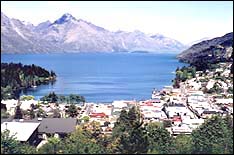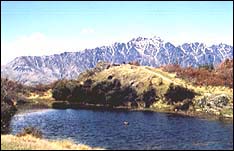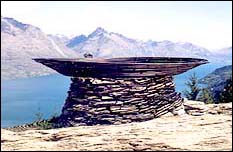Dorothy – 10/11/00
I walked up Queenstown Hill many years ago and enjoyed the views that opened up when we went beyond the exotic forest into an open tussocky area. This year the walk holds further interest as panels on the uphill side of the loop walk portray what has happened to the Queenstown area over time.
At present you enter the walk near the corner of Kent Street and Edgar Street, but subdivisions for housing are being opened up in this area, so the access point may soon be higher on the hill.
Panels tell the story of Queenstown You pass through a beautifully designed wrought iron gate depicting
 |
| The gate to the Time Walk. Photo Source Alister Hunt Click here for a larger version |
symbols of the local area.
You soon reach the first panel which depicts some of what early Maori found in the area – the tikumu (daisy), pounamu (greenstone), haramea (the plant known as wild Spaniard), and the moa (the tall bird which is now extinct. The Waitaha were the first tribe in the Queenstown area, and are thought to have been there from around 1100 AD. In the 1500s they were joined by the Ngati Mamoe, and these tribes integrated with the Ngai Tahu about 1600 AD.
The second panel describes how coastal tribes came on seasonal trips for food, trapping birds and catching eels. The native pigeon is depicted on this panel. Because of its weight and its slow flight it was fairly easily caught.
Queenstown Hill was once known as TE TAPU NUI – which means ‘very sacred’ – a place of great significance to Maori.
Pastoralism and Gold is the heading of the third panel. First came the owners of large tracts of land, building homes and intending to stay. William Rees’s homestead, which he called The Camp, became the site of the town of Queenstown. Then came the discovery of gold in 1862 and a huge increase in population. By 1863 there were twenty six hotels in the area and a hospital had been built at Frankton. In 1866 Queenstown became a municipality and the Queenstown Gardens were established.
Panel four deals with transportation. In 1878 the railway line from Invercargill to Kingston was opened. Previously the Cobb and Co coaches had taken several days to travel from Dunedin to Queenstown. Now the journey could be taken by rail and took only thirteen hours.
Steamers first operated on Lake Wakatipu in 1880. In 1912 the SS Earnslaw began to ply the lake and you still can take a trip on this historic steamer.
In 1915 motorised transport was allowed into the town. In 1936 the road from Kingston to Queenstown was opened and the aerodrome was built in Frankton.
Tourism follows naturally as the theme for Panel five. In 1939 the Coronet Peak skifield began operation. The tourism which was developing rather slowly at first was given a boost when the Government gave free holidays to Returned Servicemen after the war. In 1962 the
road to Glenorchy was opened.
The 1970s saw the building of large hotels. 1988 was the date of the first bungy jumping at the Kawarau River Bridge. 1995 brought the first direct international flights to the airport at Frankton.
The Time Walk demands only average fitness The panels on the walk uphill offer natural places to pause, read and reflect. The walk is well graded and presents no problems for people of average fitness, but it climbs steadily and for most people the excuse to pause will be welcome, especially on a hot day.
Trees on the hill The trees on the walk, mainly Douglas fir, provide shade for most of the uphill section of the Time Walk. In addition to the fir trees there are rowan, macrocarpa, eucalyptus and larch, and some native plants such as hard fern, matagouri, tussock, manuka, coprosma, and dracophyllum (the grass tree).
Beyond the forest Soon after you leave the shelter of the trees you come to a mountain tarn. The photo shows the Remarkables viewed over the tarn with a paradise duck swimming away as we approached.
|
|
| Mountain tarn at the top of the Time Walk. |
Walk a little further and you see standing out against the backdrop of the lake and the mountains The Basket of Dreams – a metal sculpture put there to mark the Millennium. The artist who created the sculpture is Caroline Robinson.
|
|
| Basket of Dreams at the top of the Time Walk. |
The plaque is inscribed: The Basket’s spiral of steel follows you inward to reflect to draw inspiration from the mountains, lake and from those who are with you, outward to dream for the future.
Time flies, eternity waits.
The Lion Foundation, Community Trust of Southland and Lottery Grants Board gave generously to this project.
The views a rich reward The views from this point and on the downhill loop of the walk are exceptional. Looking to your left towards the Frankton Arm of Lake Wakatipu you can see the settlement along the shores of Frankton Arm and at Kelvin Heights, the airport, the beginning of the road to the Kawarau Gorge, Arrowtown and the Crown Terrace, the Frankton end of the Remarkables and the road to the Remarkables Skifield.
 |
| View down the Frankton Arm. Click here for a larger version |
A short distance down the track you can see the town of Queenstown with the Gardens on the left and the steamer Earnslaw at its berth on the right, the blue waters of Lake Wakatipu, and Walter Peak on the far side of the lake.
 |
| View from the Time Walk on the downhill side of the loop. Click here for a larger version |
You may choose to walk on to the top of Queenstown Hill, which will give you a 360 degree panorama. There are also very good rock climbing areas near the summit.
Where you choose to stop will depend on your fitness and the time you have available. Allow one and a half to three hours for a shorter or longer walk.
You can see wonderful views from the top of the Gondola, but this walk gives a different perspective and the effort put in to get to the viewing points on Queenstown Hill seems to add to the enjoyment of the scenery.
For more information on Queenstown, read Queenstown For The Not-So-Energetic and Glenorchy, Queenstown’s Best Kept Secret.






